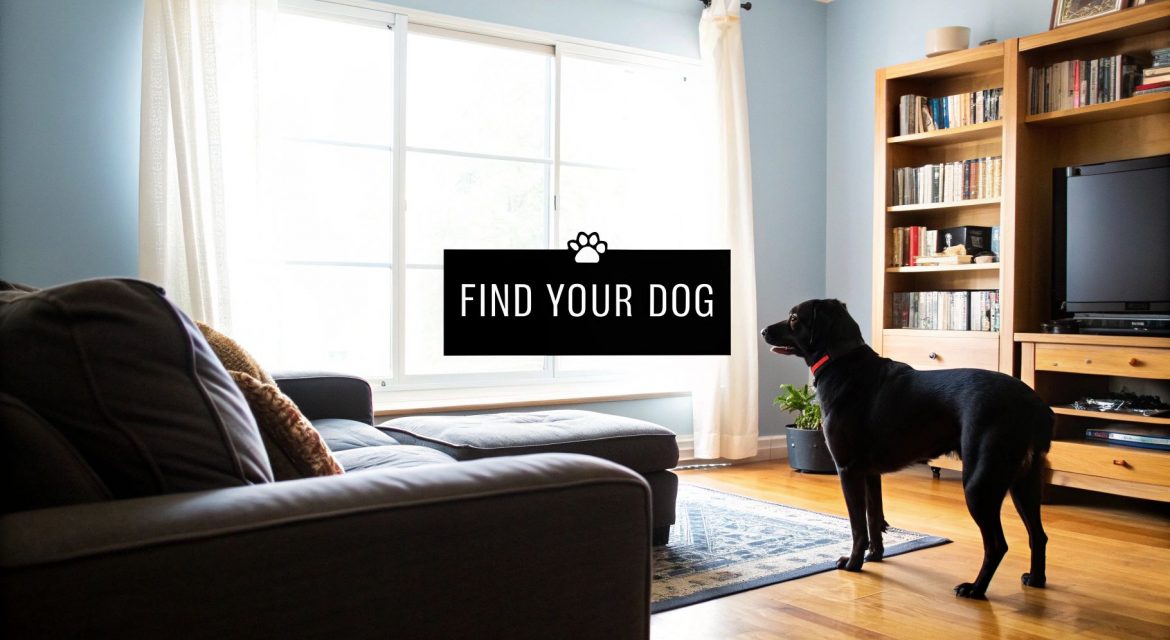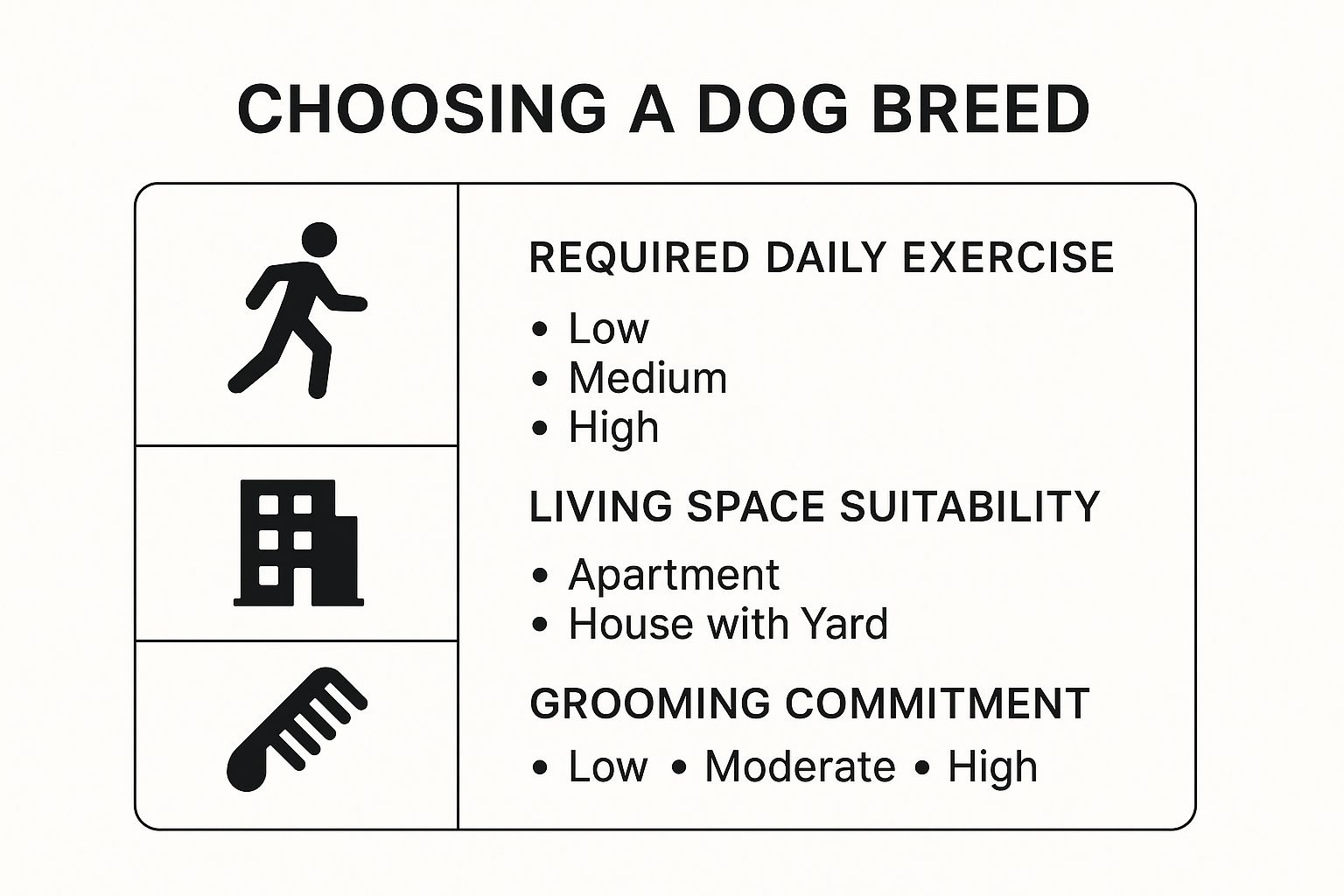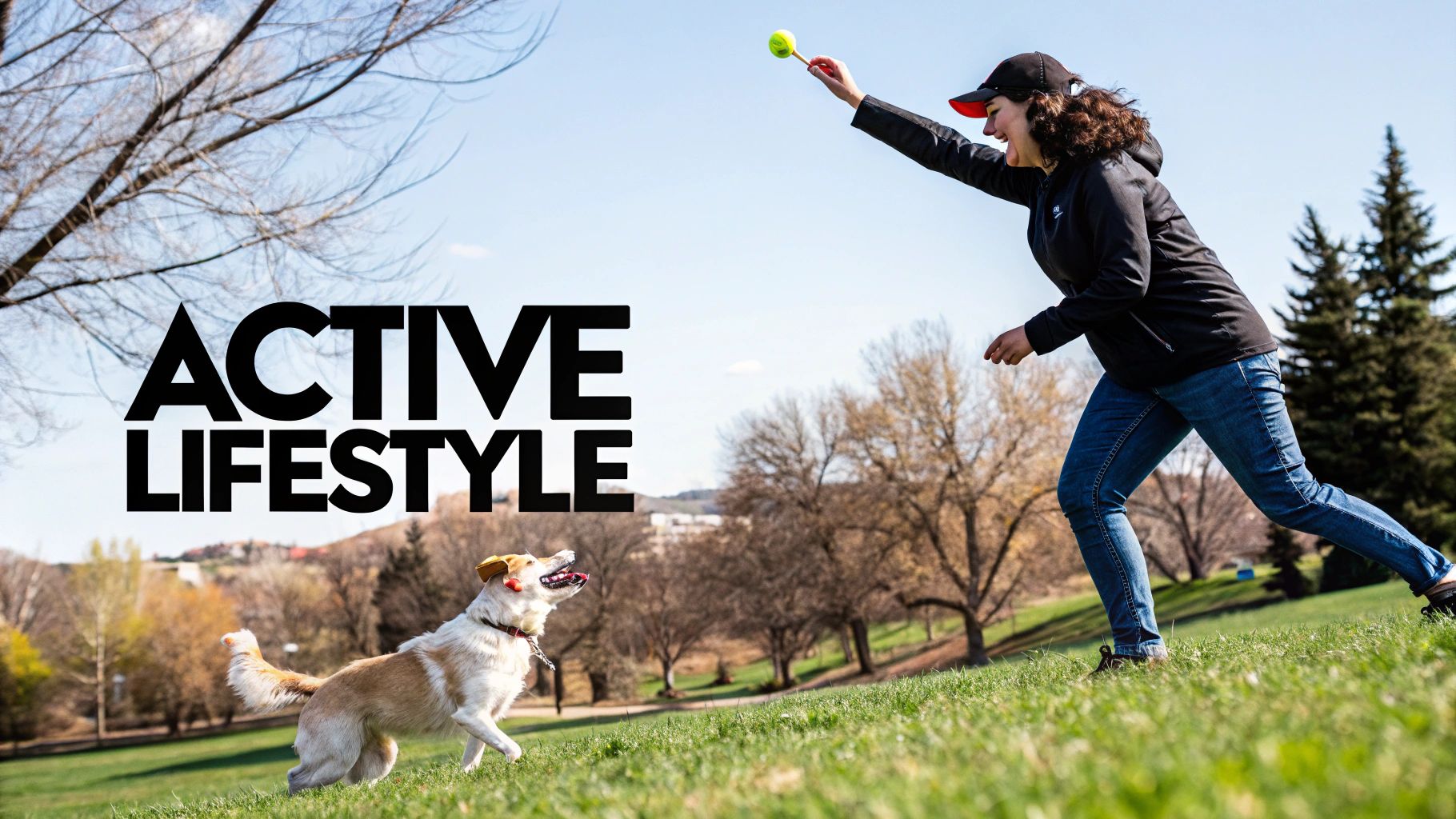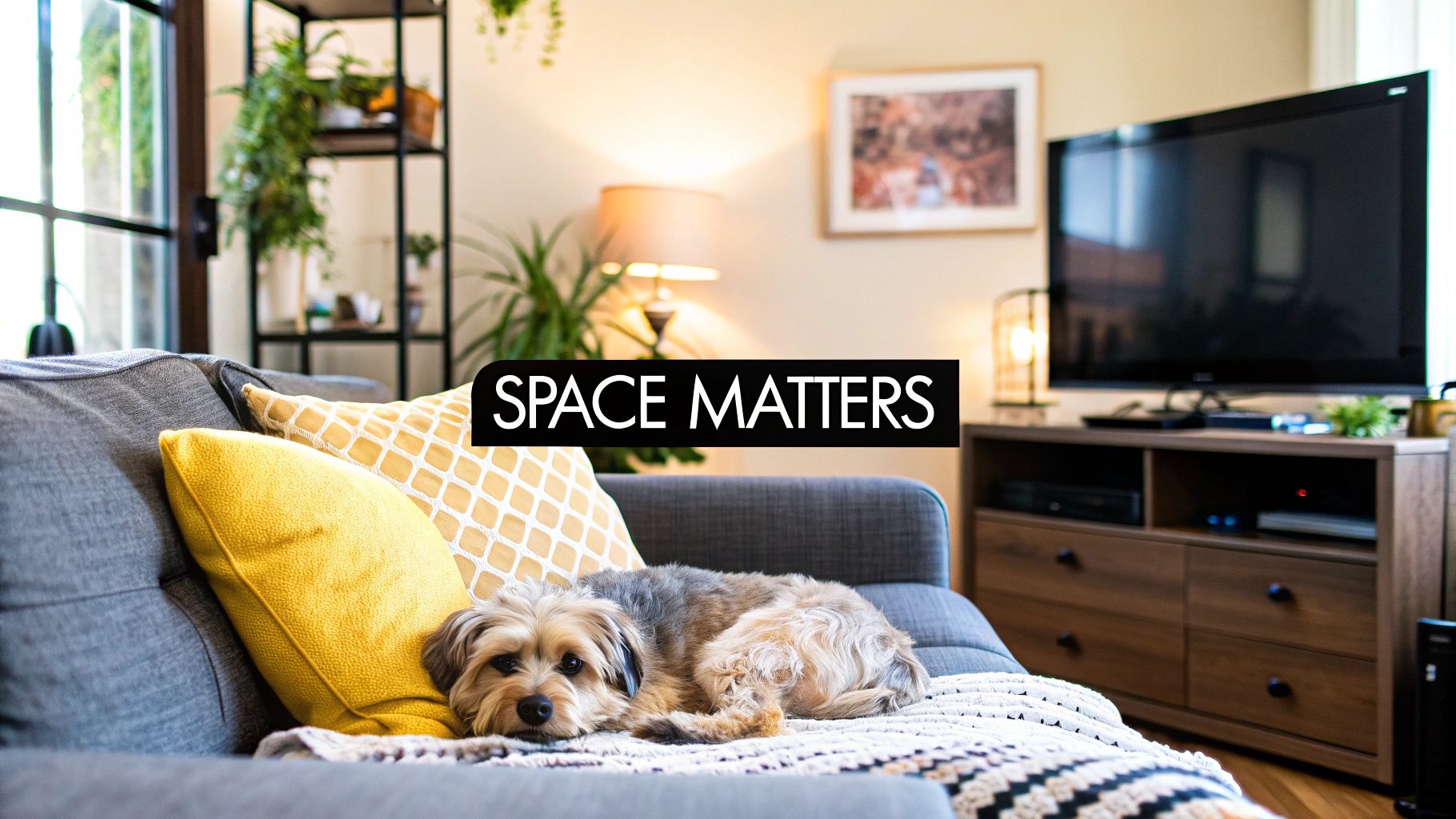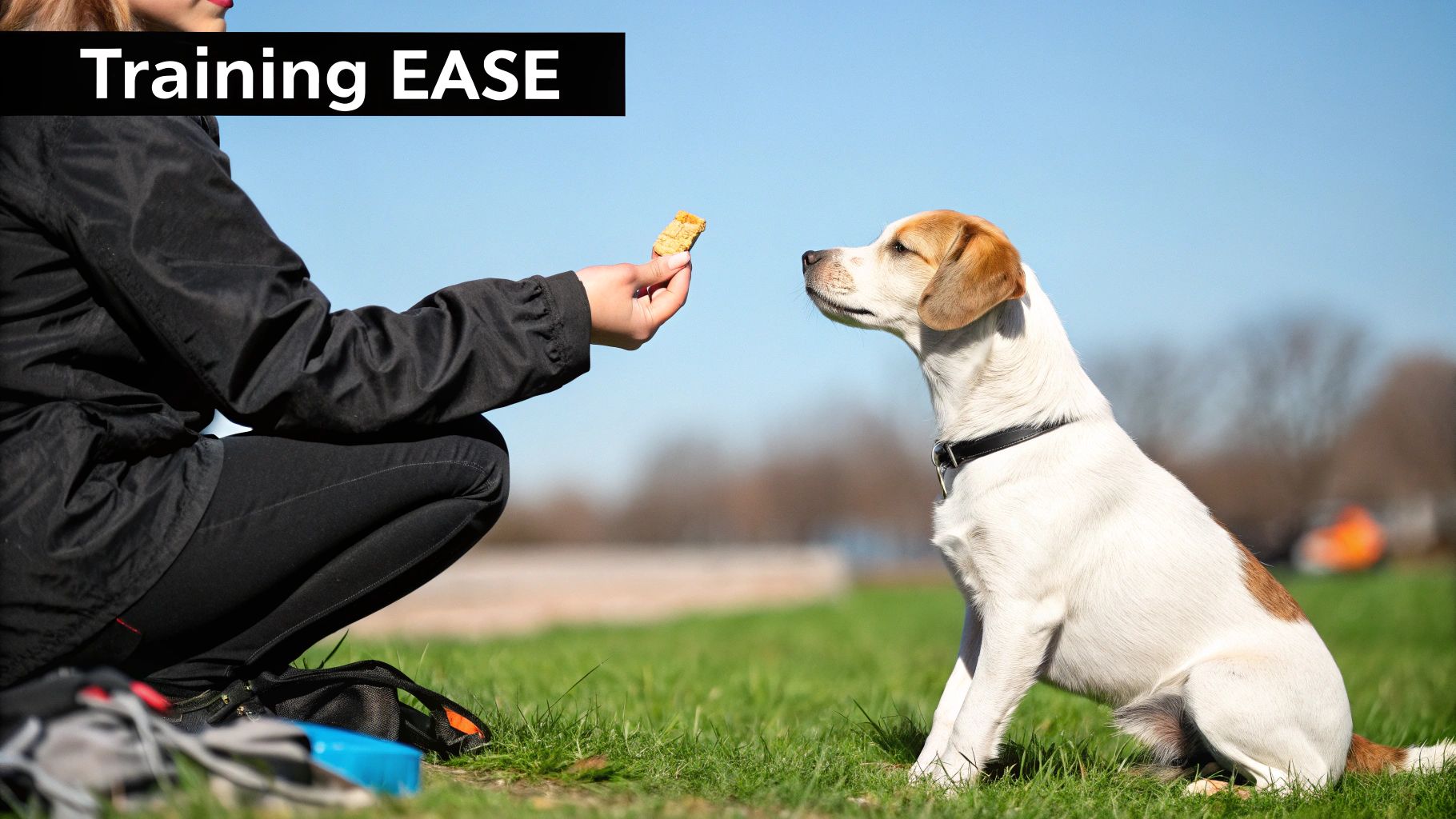Bringing a dog into your life is a massive, exciting decision. But how do we pick a breed that's actually right for us? The secret isn't just about falling for a cute face. It's about looking inward first—at your home, your daily routine, and what you're really hoping for in this new relationship.
Getting this part right from the start is what sets you up for years of happiness, creating a loving home for everyone involved.
Finding Your Perfect Canine Companion
I'm so glad you're here. Deciding to welcome a dog into your life is one of the most rewarding choices you can make, but let's be honest, it's a big one. With hundreds of breeds out there, each with its own quirks, energy levels, and grooming needs, it’s easy to feel a bit lost. That’s where we can help.
Think of us as a friendly co-pilot on your journey. From our experience, the very best matches happen when we start with a bit of honest self-reflection. A lasting friendship is built on genuine compatibility, not just initial attraction. By being realistic about our own lives first, we can turn what feels like a daunting choice into a joyful, thoughtful process.
This quick overview breaks down the three core pillars of compatibility: exercise, living space, and grooming.
Seeing it laid out like this makes it clear pretty quickly. That high-energy Border Collie might not be the best fit for a small flat, and a fluffy Samoyed's coat requires a serious time commitment you need to be ready for.
To quickly see how to choose a dog breed, use this table to match your lifestyle factors with key canine characteristics for a harmonious match.
Quick Guide to Matching Your Lifestyle with Dog Traits
| Your Lifestyle Factor | Corresponding Dog Trait to Consider | Illustrative Breed Examples |
|---|---|---|
| Live in a small flat | Low energy, smaller size, quiet nature | Cavalier King Charles Spaniel, Bichon Frise |
| Very active, love hiking | High energy, stamina, robust build | Labrador Retriever, Border Collie |
| Busy work schedule | Independent, moderate energy, content with alone time | Greyhound, Shar-Pei |
| Family with young children | Patient, gentle, sturdy, and sociable | Golden Retriever, Beagle |
| Have allergies | Hypoallergenic coat (low shedding) | Poodle, Schnauzer |
| First-time owner | Eager to please, easy to train, forgiving | Labrador Retriever, Papillon |
| Limited grooming time | Short coat, minimal grooming needs | Whippet, Boxer |
| Looking for a guard dog | Protective instincts, loyal, alert | German Shepherd, Rottweiler |
This table is a great starting point, but remember every dog is an individual. It's about finding the right individual within a breed that suits your life.
Understanding the Bigger Picture
It also helps to understand the world you're bringing a dog into. Here in the UK, the dog population is booming, with over 13 million pet dogs calling this country home. That means roughly 36% of households now have at least one dog.
Interestingly, this varies by region. In places like Telford, there are as many as 8.2 dogs for every 20 people. This popularity influences which breeds are available and shows how different lifestyles shape what makes a good match. You can explore more about UK dog ownership trends and see what it might mean for you.
We're not just picking a pet; we're choosing a new family member who will share our home, our schedule, and our heart for years to come. The goal is to make a choice that brings joy to both your life and your dog's.
Matching a Breed to Your Home and Schedule
Let's get real about your daily life, but from a dog's perspective. It’s one of the most important things to figure out when you're deciding on a dog breed. Taking an honest look at your world helps us find a friend who won't just live in it, but will absolutely thrive alongside you.
Your living situation is the first big piece of the puzzle. A small flat in central London offers a very different world than a spacious house with a garden in the Cotswolds. It's not just about square footage; it's about enrichment, safety, and giving a dog the freedom to simply be themselves.
This is where a little local knowledge goes a long way. Recent UK data shows a fascinating contrast in dog ownership. In bustling city hubs like London, you might find just one dog for every 20 people in some postcodes. Compare that to more suburban or rural spots like Telford, where the figure jumps to 8.2 dogs per 20 people.
This really highlights how your environment can shape your choice. A smaller, lower-energy breed might feel right at home in a busy city, while an active dog could relish the space of the countryside. You can explore more about how dog populations are mapped in the UK on leeds.ac.uk.
Your Home Through a Dog's Eyes
Let's think beyond just having a roof over their head. Is your home truly a safe haven for them?
- For a small dog: Are there gaps in the garden fence they could squeeze through? Are your houseplants non-toxic if they have a curious nibble?
- For a large dog: Is there enough floor space for them to stretch out comfortably without becoming a constant trip hazard for everyone?
- For any dog: Is there a quiet, cosy spot you can dedicate just to them? This could be a crate or a bed tucked away in a low-traffic corner.
A dog doesn't care about your décor, but they deeply care about feeling secure and having their own little sanctuary. Creating this sense of safety is a fundamental act of love.
The Honest Truth About Your Time
Time is our most precious resource, and it’s what your future dog will want most from you. How much do you genuinely have to give? A dog's needs don't pause for our work deadlines or social plans.
Let's think about your typical week. Are you out of the house for long hours, or do you work from home? A more independent breed might cope with a standard workday, but a highly social "Velcro dog" would find it incredibly stressful. We have to be realistic about walks, training sessions, and just simple companionship. This honesty is the foundation of a happy life together.
If you're new to this, it can feel a bit overwhelming, but our guide on the best dog breeds for beginners can offer some great starting points.
And who else shares your home? The needs of children, housemates, or other pets must be part of the equation. A breed known for its patience is essential for a home with young kids, while a dog with a high prey drive might not be the best choice if you already have a cat. It's all about creating a harmonious home for everyone, two-legged and four-legged alike.
Decoding Breed Temperament and Energy Needs
Okay, so we've looked at your world. Now it's time to step into your potential dog's inner world. This is a crucial shift when figuring out how to choose a dog breed. Every single breed was created for a reason, whether that was herding sheep across rugged hillsides or simply keeping a royal lap warm.
This history isn't just trivia; it's the blueprint for their core temperament and energy levels. It’s precisely why a Border Collie, bred for intense, non-stop work, will literally climb the walls if they don't have a 'job' to do. On the flip side, a Basset Hound is genetically wired for a much slower pace of life.
We need to get past the cute photos and truly understand what 'high-energy' or 'independent' means in the real world. Being brutally honest about matching a dog’s innate drive to your own activity level is non-negotiable if you want a happy, peaceful home.
What Does ‘Energy Level’ Really Mean?
When you see "energy level" in a breed profile, don't just think "walks." It's a much bigger picture, covering their need for both mental and physical stimulation. Let's break it down together with some real-life examples:
- Low Energy (e.g., Basset Hound, Bulldog): These pups are the masters of chill. They're usually happy with a couple of leisurely strolls a day and plenty of time snoozing on the sofa. They make fantastic companions for a quieter, more relaxed lifestyle.
- Medium Energy (e.g., Beagle, Cocker Spaniel): These dogs need consistent daily exercise. Think a brisk walk, a good game of fetch in the garden, and maybe some puzzle toys to keep their clever minds ticking over.
- High Energy (e.g., Border Collie, Belgian Malinois): This is a serious lifestyle commitment, not just a hobby. These dogs often need upwards of two hours of vigorous exercise every single day, plus an ongoing 'job' like agility or scent work to stop boredom and anxiety from setting in.
Decoding Key Temperament Traits
Beyond just their 'get up and go', a dog's personality is a rich mix of different traits. Getting to grips with these will help you find a character that genuinely clicks with your household's rhythm. For instance, some people crave a Velcro dog, while others prefer a more self-sufficient companion. If you're firmly in the first camp, our guide on the most loving dog breeds might be a useful read.
Understanding a breed's original purpose is like being given a cheat sheet to their personality. A dog bred to work alongside people will have a very different nature from one bred to work independently.
Think about these core traits:
- Sociability: How do they typically act around strangers, children, and other animals? A Golden Retriever is famously a friend to all, whereas a Chow Chow can be much more aloof and reserved with people they don't know.
- Trainability: How eager are they to please and learn? A Poodle is known for its whip-smart intelligence and willingness to learn. A Beagle, however, is often led by its incredible nose, which means you might need a bit more patience and creativity during training sessions.
- Independence: Does the dog need to be in your pocket 24/7, or are they happy to do their own thing? A Siberian Husky is notoriously independent, while a Cavalier King Charles Spaniel absolutely thrives on being close to its family.
Planning for Lifelong Health and Grooming Costs
Bringing a dog home is a lifelong promise, and a huge part of keeping that promise is being prepared for their ongoing, practical care. When you're figuring out how to choose a dog breed, it’s all too easy to get swept up in the excitement of temperament and energy levels. But we have to be realistic about the real-world time and money needed to keep them healthy and happy.
Let's talk grooming first. That fluffy Samoyed is a truly magnificent sight, but its stunning white coat demands a daily brushing commitment to prevent painful matting. On the other hand, a sleek Vizsla needs far less day-to-day attention. Neither is "better," but you need to be brutally honest with yourself about which routine you can genuinely stick to.
Understanding Coat Types and Their Needs
A dog's coat is more than just for looks; it's functional and has very specific care needs. The choice you make here will directly impact your weekly schedule and your wallet.
- Smooth Coats (e.g., Whippet, Boxer): These are the most straightforward. A quick brush or wipe-down once a week is usually all it takes to keep them looking sharp.
- Double Coats (e.g., German Shepherd, Husky): These dogs have a dense, insulating undercoat and a tougher outer coat. They "blow" their coat twice a year, which means you're in for intense shedding seasons where daily brushing is an absolute must to manage the fluff.
- Long or Silky Coats (e.g., Yorkshire Terrier, Afghan Hound): These gorgeous coats are magnets for tangles and mats. They often require daily brushing and regular appointments with a professional groomer to stay in good shape.
- Wiry Coats (e.g., Border Terrier, Schnauzer): These coats need special attention, often involving professional hand-stripping a few times a year to maintain their unique texture and health.
Being realistic about grooming is a true act of kindness. A matted coat isn't just unsightly; it's painful and can easily lead to nasty skin infections. Choosing a coat you know you can manage is a fundamental part of ensuring your dog's comfort.
Health and Responsible Breeding
Even more critical than grooming is a breed's potential health profile. It's a sad reality that many purebred dogs are predisposed to certain genetic conditions. For instance, brachycephalic (flat-faced) breeds like Pugs and French Bulldogs can face severe breathing difficulties, while German Shepherds have a well-known higher risk of hip dysplasia.
This isn't meant to scare you off; it's about empowering you to be a proactive and responsible owner. Researching these potential issues is a non-negotiable step. A truly reputable breeder will be completely transparent about the health screenings they perform on their dogs—things like hip and elbow scores or DNA tests for specific hereditary conditions. Asking about this isn't rude; it shows you care deeply about the future welfare of your companion.
Ultimately, the true cost of ownership goes far beyond the initial purchase or adoption fee. This is the long-term budget for food, routine vet check-ups, pet insurance (which we strongly recommend), training classes, and grooming. Being financially prepared from the start means you can always provide the best possible care for your dog throughout their entire life with you.
Right, you’ve done the soul-searching and have a shortlist of breeds that feel like a good fit. Now for the exciting part—moving your research from the screen to the real world. This is where you get to connect with the dogs themselves, and honestly, nothing beats that hands-on experience for seeing if the chemistry is really there.
Your next mission is to find people who live and breathe your chosen breed. This isn't about finding the quickest option; it’s about finding the right one for your future best mate. Let's make sure you connect with people who are just as invested in their dogs' happiness as you are.
Where To Find Reputable Experts
Starting your search for a responsible source can feel a bit overwhelming, but there are dedicated communities out there ready to help you. These are your best bets for getting honest, in-depth information from the real experts.
- Kennel Club Assured Breeders: These aren't just people who sell puppies. Breeders under this scheme are held to high standards for dog health and welfare. They carry out mandatory health screening for known breed issues and are expected to provide a lifetime of support.
- Breed-Specific Rescue Organisations: The people running these charities are incredibly passionate volunteers with deep, hands-on knowledge. They can give you an unfiltered look at both the joys and the challenges of the breed, and they are masters at matching the right dog to the right home.
Another fantastic way to immerse yourself is by visiting a local dog show or a breed-specific meetup. It’s a brilliant opportunity to see different personalities within a single breed, all in one place, and chat with experienced owners who are nearly always happy to share their stories.
Asking The Right Questions
When you finally connect with a breeder or rescue, having a few key questions ready shows you’re a serious and committed potential owner. Think of this as your chance to verify everything you've learned so far.
A truly responsible source will welcome your questions and be completely transparent. They should be just as keen to interview you as you are to interview them—their priority is finding the perfect home for their dog.
Make sure you ask about things like:
- Health Testing: "What specific genetic health tests have the parents had, and could I see the results?"
- Socialisation: "How have you socialised the puppies/dog? What kinds of experiences have they had so far?"
- Parental Temperament: "Can you tell me about the mother's personality? Is it possible to meet her (and the father, if he's around)?"
These questions about temperament are more important than you might think. With 31% of UK households now owning dogs, the main driver is the emotional connection they bring. UK data shows 51% of owners say their pets make them happy, with others citing love and companionship as the top reasons. This just goes to show that choosing a breed with a personality that clicks with yours is the real key to finding that joyful bond. You can find more on these ownership trends at Dogster.com.
This final research phase is all about confirming your choice. It's about making absolutely sure that a breed's needs align with what you can genuinely offer, especially if you live in a smaller space like a flat. For some tailored advice on that front, you might find our guide on the best dog breeds for apartments really helpful.
It’s in these real-life conversations and interactions that you’ll feel that little spark—the one that tells you you’ve finally found your match.
Common Questions About Choosing a Dog Breed
As you get closer to making one of the most exciting decisions of your life, it's completely natural for a few last-minute questions to surface. Think of this as our final check-in before you take the leap. We've gathered some of the most common queries we hear from people just like you, aiming to give you clear, practical answers that build your confidence.
This whole process is a journey of both the heart and the head. Feeling a bit of uncertainty at this stage is actually a good sign—it shows you're taking this responsibility seriously. Let’s tackle these common questions together.
Should I Get a Puppy or an Adult Rescue Dog?
This is a fantastic question, and one that gets right to the heart of what you can realistically offer a dog. There's no single "right" answer here, only what's right for you.
A puppy offers a completely fresh start. You get the undeniable joy of watching them grow, shaping their behaviour from day one, and knowing their entire history.
But that blank slate comes with immense demands. You are their entire world for house-training, socialisation with other dogs and people, and learning the most basic cues. Be prepared for a 24/7 commitment for the first several months. It's a huge, but rewarding, undertaking.
An adult rescue dog, on the other hand, often comes with a more established personality. This can make it easier to see if they're a good fit for your home. They might already be house-trained or know a few commands. Of course, they may also bring a history that requires extra patience and understanding as they learn to trust again. Both paths are incredibly rewarding; the best choice depends entirely on your experience, time, and emotional readiness to adapt.
Are Crossbreeds Like Cockapoos a Good Choice?
Crossbreeds can make absolutely wonderful family pets, but it's crucial to go in with your eyes wide open. Their massive popularity has unfortunately led to a surge in irresponsible breeding. It is vital to find a breeder who conducts comprehensive health tests on both parent breeds for the genetic issues they are known for.
Unlike with purebreds, the traits of a crossbreed can be very unpredictable.
You are essentially getting a genetic lottery. When you mix a Poodle and a Cocker Spaniel, you might get any combination of their traits—from coat type and size to temperament and energy levels. You could get the low-shedding coat of a Poodle or the higher-shedding coat of a Spaniel.
Your best bet is to thoroughly research both parent breeds. This way, you'll understand the full spectrum of possibilities and be prepared for whatever wonderful, unique combination you end up with.
What Is the Biggest Mistake People Make?
From our experience, one of the most common and heartbreaking mistakes is choosing a dog based on looks alone. It's so easy to do. We fall for a beautiful coat or a cute face without researching the engine running underneath—the breed's temperament, exercise needs, and intelligence. This is a recipe for frustration for both human and dog.
Another major pitfall is underestimating the true commitment of time and money. A high-energy dog in a low-activity home isn't a minor inconvenience; it can lead to serious behavioural issues born of boredom and anxiety.
The best way to sidestep these mistakes is to be ruthlessly honest with yourself during that initial lifestyle assessment we talked about earlier.
At My Life My Dog, we're committed to helping you build a beautiful, lasting bond with your canine companion from the very first day. We provide in-depth resources and expert advice to support you through every stage of your journey together. Discover how we can help you and your new best friend thrive at mylifemydog.com.


